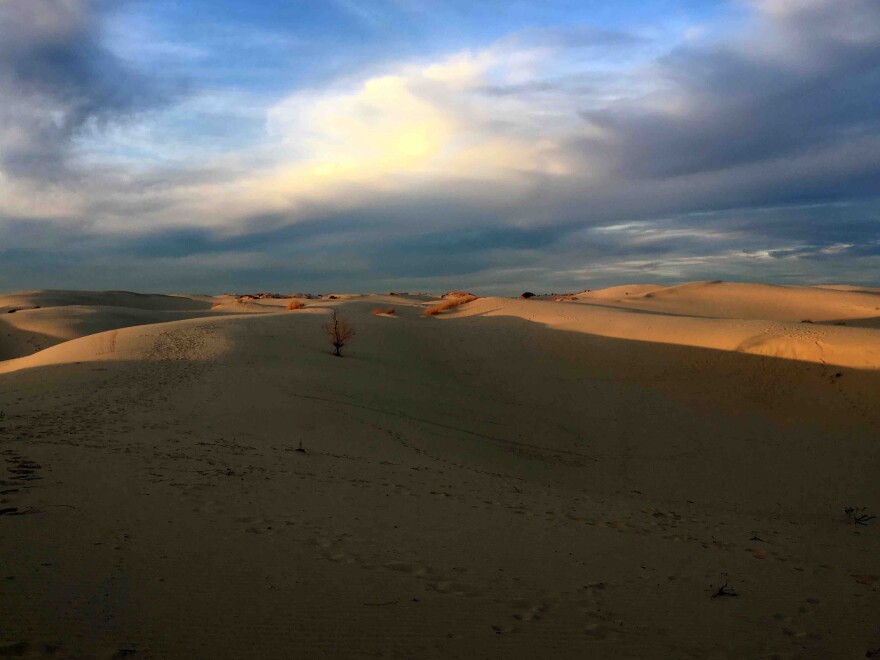It's a place of serenity, a West Texas landscape with the power to mesmerize. Monahans Sandhills State Park encompasses almost 4,000 acres of sand dunes and sandhills – part of a larger expanse of sandhills here at the southwestern edge of the High Plains. The sandhills are an ecosystem unlike any other in Texas, and they conceal a surprising diversity.
Monahans' fortunes have ebbed and flowed since the 19th century. Its economy contracted with the oilfield bust of the 80s. Now, it's in the midst of a fracking boom. Thousands of wells have been drilled. Housing is scarce. There's daily rush-hour traffic on Interstate 20.
But out in the dunes, that haywire pace recedes. It's a surreal landscape. Walking in the dunes – arduous in the loose sand – the visitor enters a kind of timelessness.
Michael Smith is park manager.
“The main picnic areas are a mile and half to 2 miles back off the interstate,” Smith said, “but you would never know back there that you're only a mile and a half from Interstate 20 – and about a mile and a half from some of the busiest parts of the oilfield right now. It's like being in a totally different world.”
These sands accumulated against the edge of the Llano Estacado in the Ice Age. They're made of quartz – and the grains are smaller, and more perfectly round, than seashore sands. They're easily swept along by wind and water. Waves of sand rolls over the dunes on windy days – enough to sand-blast a hiker.
The sandhills stretch for 200 square-miles, from New Mexico nearly to I-10. The park is in the midst of this expanse. The sands become finer, the dunes more pronounced and less vegetated, from north to south.
They were an obstacle for early westering travelers. But the no-man's-land appearance is deceptive, Smith said.
“It is so unique and different,” he said. “It's the only place in Texas where this particular type of ecosystem is protected. It's the only place in Texas where this specific ecosystem even exists.”
An attentive visitor soon sees signs of life. Raptors wheel overhead. Tracks are impressed in the fine sands – of javelina, mule deer. Coveys of quail – both bobwhite and scaled – flush from pockets of brush. There are cottontails, jackrabbits, kangaroo rats, coyotes. Badger dens marks the dunes.
This surprising diversity has historically been sustained by a unique sandhills feature – natural oases known as “seeps.”
Dunes are typically gentle on wind-ward facing slopes. But on the far side, the wind cuts trenches. These trenches can reach the water table, and fill with water. Some are surrounded by willows.
Native peoples were drawn to the dunes, and these oases, for millennia. Both the Apache and Comanche visited. The park contains a haunting reminder of this history: a partially buried wagon train, whose occupants fell to a Comanche raid.
Always sensitive to drought, the seeps have declined with groundwater pumping – for drinking water, and for fracking.
The park contains bare dunes, and grasslands. Counterintuitively, it's also part of a vast oak forest. “Shin oaks,” usually less than 5 feet tall, crown some dunes. Their acorns are a staple for dunes wildlife.
The park is the only “green space” in the Monahans area, and the community's investment is deep. The park's Dunagan Visitors Center is named for local benefactors. The Chamber hosts an annual 5K/10K run here. “Sand-surfing” is popular, especially for the young, and the park is a destination for birthday parties and family events.
“Even during difficult times when the budget for state parks wasn't what we would hope it would be, they rallied behind this park again and made sure this park was not closed,” Smith said. “The community very strongly supports this park – both with their visitation, just coming out and enjoying the park, paying their entrance fees – but also showing up when there are special events, and helping out.”
The growing frac boom creates challenges. Smith has implemented policies to ensure oilfield workers don't monopolize campsites. “Sand plants,” where sand is harvested and sold for drilling, surround the park, and light pollution has made stargazing – once a popular activity – impossible.
But the sandhills still cast their spell. Smith hopes that the community's love for the sandhills will help safeguard this unique West Texas place for the future.



